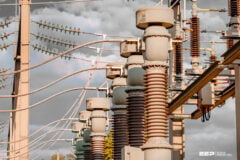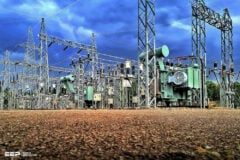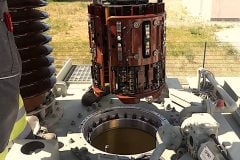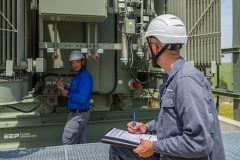Where Does the Sound Come From?
Noise is caused by magnetostricition (changes in shape) of the core laminations while the transformer is energized. Transformers emit a low-frequency, tonal noise that people living in their vicinity experience as an irritating “hum” and can hear even against a noisy background.

The electrical power industry produces a range of solutions to abate humming, which originates in the transformer’s core and, when it is loaded, in the coil windings. Core noise is generated by the magnetostriction of the core’s laminations when a magnetic field passes through them.
As the phenomenon occurs it causes air columns to be formed in the spaces between the transformer core and the low-voltage windings of the core and other adjacent parts of the transformer, and these air columns cause audible noise as it moves between the various parts of the transformer.
Magnetostriction takes place at twice the frequency of the supply load: for a 60 Hz supply frequency, a lamination vibrates at 120 cycles per second, and the higher the density of the magnetic flux, the higher the frequency of the even number harmonics.


Also, the audible sound produced by fan-assist cooled (FAC) transformers is partially due to the energizing of the core by the alternating voltage applied to the windings and also by the fans forcing air through the coils. The noise generated by the core, and whose fundamental frequency is twice the frequency of the applied voltage, will create audible sound that will be present even under no load conditions.
Amplification of audible sound can occur in a given area due to the presence of reflecting surfaces.
Transformer hum also arises through the vibration caused when the load current passes through the windings, interacting with the leakage flux it generates. This “load noise” level is determined by the size of the load current.
Control of Transformer Sound Transmission
Acoustical-absorbing material should be mounted on reflecting surfaces to reduce sound reflection and possible amplification. Transformers should be mounted on a firm support having as great a mass as possible.


Vibration pads or properly designed isolation mounts under the transformer will reduce transmittal of sound. The neoprene rubber isolation pads (Figure 2) provided with the unit should be installed between the transformer and its mounting surface. is will reduce case vibration and compensate for slight unevenness of the mount.
Care must be taken to ensure proper and tight installation of conduit. Flexible conduit is recommended.
A normal conversation is typically 60-70 dB. OSHA has an actionable level to sound exposure at 85 decibels whenever noise levels equal or exceed 8 hour time weighted average sound of 85 decibels, or a dose of fifty percent (29 CFR 1910.95(c)(1).
Per General Electric Installation Guide No. 475A667AAP008, dry type transformers are designed and manufactured to comply with NEMA and ANSI standards. e decibel values referenced below (Figure 2) represent average values obtained in a sound laboratory per industry standard test procedures.
Figure 2 — Average Sound Levels for Dry Type Transformers (Courtesy of General Electric)
| Size (kVA) at 150° C Rise | Average Sound Level in Decibels (ANSI C89.2) |
| 0 – 9 | 40 |
| 10 – 50 | 45 |
| 51 – 150 | 50 |
| 151 – 300 | 55 |
| 301 – 500 | 60 |
| 501 – 700 | 62 |
| 701 – 1000 | 64 |
| All with fans | 67 |
Noise is defined by Merriam-Webster as “any sound that is undesired or interferes with one’s hearing of something”.
So who is to say what sound is undesired or interferes with something? What may be a calming sound of transformer (humming to some), may be a nuisance to others.
Just as rock concerts may be annoying to some, and the loud music and rhythm may be stimulating and desirable to others.
When initially tested and commissioned make sure you carefully inspect the shipping bolts, packing materials, and resilient mounts so sound is kept at a minimum. Removal or loosening of the shipping bolts will allow for a smooth transfer of vibration and should reduce the overall noise generated by the unit.
Reference // Dry Type Power Transformers: Understanding Transformer Isolation and Noise by Ron. A. Widup, Executive Vice President/General Manager of Shermco Industries











For the past two months there has been a pulsating hum in my house. In trying to troubleshoot the problem I turned off all utilities to the house and the pulsating hum continued. The hum increases in intensity at certain times of day. Usually 9-11 pm and 6 – 11 am it is loudest. It either quiets down during the day or becomes inaudible. I’ve tried to record it and only got static. I’ve recorded it on a decibel meter and hear it pulsating along with the pattern the decibel meter is making, but it averages only 10 dB and increases up to mid-20’s. Over time I’ve realized it’s more of a feeling in the air than a sound. I finally put it all together and now believe the source is an electrical transformer about 15 feet from my house. This same thing happened last spring, but for a shorter duration and not nearly as noticeable then went away and I forgot about it. This spring however, it’s been unbearable. At times it has continued for 40 hours straight at varying intensities. So, my house is on slab on top of bedrock. The transformer seems to be running a bit louder than it should be. I’m thinking that when the soils are saturated the hum from the transformer is traveling under the slab, getting broken up along the way, turning into a pulsating hum by the time it is resonating up through the slab. Now, how do I get the utility company to service the transformer? They’ve been to the house twice to look at the meter, which I’ve told them I never thought was the problem since it’s coming up through the slab, and they have refused to come to the house again. Any insight into this problem would be very much appreciated. Living in this house has been unbearable at best.
We have a green pad mount transformer box approx. 20′ from our house.
We also have a constant resonant frequency hum throughout the house which is
not loud but annoying enough to keep my wife from sleeping. The noise is not detectable in walls, floors, or ceiling, but is “in the air”
Is it likely that the noise is being transmitted from the transformer box ambiently or directly? If the source is the transformer box, can anything be done to eliminate the noise?
Did you ever get anywhere with this? I have the same problem.
I have a feeling that this article will become a very important one to me, given my dream home’s odd electrical system: 480v trunks leading to each room being stepped down and split into multiple 120v branches. The reason for this is the high load I can put on a room. As it stands right now, I may have to rewire my bedroom to get enough capacity to run the equipment I am going to put in it.
Oh, and for the record, Transformer hum does not make me nervous. i quite like it actually (though, as you pointed out, others may not).
I am hearing a constant hum in my house that I have identified as about 60hz. Maybe a bit higher. I shut off the mains to my house and no change, and water , stereos, etc. Still a hum. Noticeable at night when all is rather quiet. It has a slight fluctuation but it’s regular.
Recently a commercial building was constructed next to my house with an outside transformer about 100 yds from my home. The building also has an air exchanger on the roof. And security lights at night that turn off at midnight. The hum is still present when lights shut off.
The hydro manager in the city say they never heard of this before. And it couldn’t be the transformer. I have a list of things I need to check off to rule out as much as I can. A drag. Even try to record the sound which would be impossible. Ears can hear it just fine.
So, could the transformer be the culprit? Emitting then vibration capable of traveling through the ground ? I have read that it is quite possible. But as the city said, it’s a brand new unit?